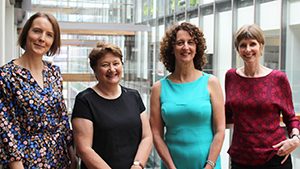
This blog post by Abby Haynes describes important lessons from the implementation of SPIRIT (Supporting health with Research: an Intervention Trial), a novel multi-component trial designed to increase individual and organisational capacity to use research in policy making.

When external providers deliver a complex program in an organisation, it is crucial that someone from that organisation—a liaison person—gives ‘insider’ advice and acts as a link between their organisation and the program providers.
What are the characteristics to look for in filling that role? And how can liaison people best be supported?
Six Sydney-based health policy organisations took part in SPIRIT – each nominating a member of their staff to coordinate its implementation in their organisation.
These liaison people turned out to be far more than administrators – they had a profound impact not only on how the program was implemented, but on perceptions, engagement and participation across their organisations.
Nine tips for identifying and supporting liaison people
1. Champions: The liaison person must believe that the program is worthwhile
The ideal liaison person is:
- a champion: someone who genuinely believes in the program and advocates for it energetically
- an opinion leader: someone with informal organisational influence
- a boundary spanner: someone well-connected in their workplace who can also communicate effectively with the program providers.
We found that where liaison people held an indifferent or negative view of the program they unintentionally undermined it, while those who were enthusiastic amplified others’ enthusiasm. So genuine support for the program is more important than influence or connections.
2. Credibility: The liaison person should be an authentic advocate for the program
Colleagues judged the suitability and effectiveness of their liaison person in terms of how well they modelled and espoused research-informed policymaking. This suggests that for a liaison person to be a credible champion they must be perceived as someone who believes in what they are saying and knows what they are talking about.
3. Connections: The liaison person should have sound cross-organisational knowledge and networks
The program was more creatively tailored and integrated, and better attuned to each organisation’s professional development expectations, when their liaison person consulted with colleagues and advised the program providers. Liaison people’s ability to act as intermediaries required them to have (or be able to rapidly acquire) knowledge about multiple aspects of their organisation.
Broad connections across the organisation ensured that their championing efforts were not restricted to local contexts, but it was their nuanced understanding of diverse organisational needs and perspectives that enabled them to represent and respond to their colleagues so effectively.
4. Social skills: The liaison person should have good interpersonal and communication skills
The quality of connections was as important as the quantity for supporting organisational understanding and engagement.
Our most effective liaison people were persuasive, approachable and well-liked: people are more inclined to do things for people they like. Adaptability and project management skills were also vital.
5. Support: Organisational leaders need to visibly back the liaison person as well as the program
Strong, visible support from managers assured liaison people that their efforts – even when they verged on ‘nagging’ – were seen as reasonable and warranted.
Colleagues confirmed that evident support from above increased the liaison person’s authority and demonstrated they were acting on behalf of management.
6. Incentives: If possible, the liaison person role should be incentivised within the organisation
Liaison people were more enthusiastic about the implementation when they benefited professionally from the role.
This included building tasks into performance indicators and increased organisational status or exposure. But incentives should not pressure liaison people to coerce participation.
7. Clear expectations: Organisations need clear upfront guidance about the liaison person role
The liaison people in our study had strikingly different perceptions of their role (e.g. as event organisers, project managers, collaborators, connectors, translators and integrators).
Liaison people and their managers needed to see the role as skilled facilitation rather than merely administration, and to understand its key attributes, responsibilities, support needs and likely time commitments. The program providers must describe these clearly and realistically.
8. Flexibility: The liaison role can be interpreted by each organisation
Providing it does not compromise implementation fidelity, it may help to take a flexible approach to the liaison role, so that core objectives and tasks are specified but the strategies for achieving them are developed locally.
For example, organisations might prefer to divide the role between two members of staff: one taking responsibility for administration and another for creative and strategic decisions.
9. Collaboration: The program providers should work with the liaison person in planning and problem-solving
Where liaison people shared insider knowledge, harnessed local communication channels and made suggestions for increasing the benefits of the program, activities were assessed by the program providers and participants as more attractive and useful.
This suggests that working with liaison people as program development partners, rather than as conduits, could increase our ability to develop fit-for-purpose programs that respond sensitively to local conditions.
Participants: This blog post was written by Abby Haynes on behalf of CIPHER (Centre for Informing Policy in Health with Evidence from Research). Members of CIPHER involved in the research on ‘liaison people’ were: Abby Haynes (Sax Institute and University of Sydney), Sally Redman (Sax Institute), Anna Williamson (Sax Institute), Sue Brennan (Australasian Cochrane Centre, Monash University), Gisselle Gallego (University of Notre Dame), Stacy Carter (University of Sydney), Sian Rudge (Sax Institute) and Phyllis Butow (University of Sydney).
Find out more
- Research paper: The pivotal position of ‘liaison people’: Facilitating a research utilisation intervention in policy agencies
- Opinion piece: Secondments open door to enhanced knowledge translation
- This post was originally published on the Integration and Implementation Insights blog.





